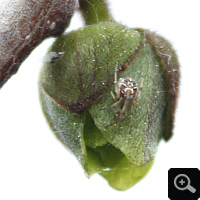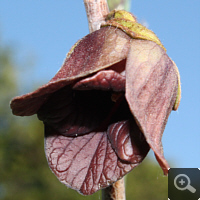Common Pawpaw (Asimina triloba)
Overview
The Common Pawpaw ist the only hardy member of the Annona family (Annonaceae). It comes from Eastern North America. Since thousand years it is utilised by Native Americans and named by them as Pawpaw (pronounced: ‚Paupau‘). In Germany it is called ‚Indian Banana‘. It received later this designation rather as marketing term. During the last years arose a real hype about the plant. It was marketed to unconscionable high prices by special nurseries. After it is increasingly offered in garden centres, you can buy it to acceptable prices though.
Description
Free-standing Pawpaws reach as trees or bushes with a pyramidal growth a height of three to five metres. Leaves are pointed oval, smooth and maximal 20 centimetres long. They are thrown in winter.
At the ends of the previous year’s branches are one to four blossoms per leaf axil produced. These are puce and distribute an unpleasant smell, which shall attract flies and other necrophagous insects.
Fruits shall taste very well. Depending on the sort they reach maximal a length of ten centimetres and a weight ot circa 200 grammes. They have a whitish to yellow, soft and creamy fruit pulp and are interspersed with great, disc-shaped, black-brown seeds. Consistency of the fruit pulp is faintly reminiscent of bananas. As regards taste it shall correspond to a tropical fruit cocktail from banana, ananas, mango and vanilla. In order that fruits mature completely, they require a long and warm late summer. They have achieved full ripeness, when skin turns yellow green. Because they take quickly a fermented taste, they must be consumed within a few days. However , ripening process can be delayed for some days by a storage in the fridge.
Pawpaws are rich in unsaturated fatty acids, proteins and different mineral substances like calcium, potassium and iron. Its vitamin C – content is above the content of an apple, furthermore it contains vitamin E.
Culture
Because Pawpaws are excellently hardy, they can be confidently planted out in full sun. They prefer a nutrient-rich, moist, but water-permeable soil.
Pawpaws do not require a special pruning. So far the ‚spindle tree‘ has proved successful as pruning method. For this purpose sideshoots remain normally uncut. Only too steeply ascending sideshoots are cut or tied down on an angle of circa 60°.
You should always plant several sorts, because most sorts are self-sterile. Also the self-fertile sorts ‚Sunflower‘ and ‚Prima‘ carry distinctly higher yields in the case of cross-pollination. Because pollinator insect species do not exist in Middle Europe, a pollination by hand should takes place for a sure fruit set.
Before sowing seeds should be stratified in the cold for circa three months. Sowing takes places at exceeding 20° C. For a member of the annona family typical is the long germinal duration of up to two months. Thereafter the seedling is unpretentious, but grows slowly. In addition Pawpaws can be bred by grafting and by root cuttings.
They are considered to be very resistant to vermin and diseases.
Experiences
2011
In spring a cheap, 20 cm high specimen (without sort declaration) of this otherwise still very expensive plant was offered to me. Of course I was not able to resist and have enhanced my garden by a further species.
2012
The little plant has survived the very severe winter without damages. Therefore frost- hardiness of the Pawpaw is actually excellent. In view of this fact I have planted four further specimens: Two self-fertile sorts (‚Prima 1216‘ and ‚Sunflower‘) and two self-sterile (‚Davis‘ and ‚Overleese‘).
2013
Also the second winter was survived easily. In spring appeared the first blossom at the plant. Because the plant is still relatively little a fruit set failed though.
At midsummer plants suffered some from the long-lasting heat.


